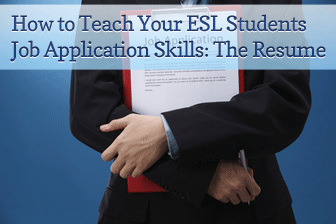How to Teach Your ESL Students Job Application Skills: The Job Hunt


Your students study English for many reasons. Some study for educational purposes, some because they have moved to a location where English is the dominant language, still others because they feel a connection and a draw to Western culture. Many ESL students, though, choose to study English to further their careers and open opportunities for future employment. For these students, it is important to communicate the expectations for employees as well as the process of job application that is conducted in English. In this article, you will find how to walk your students though the resume writing process as they start their job searches.

The Objective
Many resumes start with an objective, though this section is optional. In the objective section the writer states his or her goals for employment. If a person is applying to a specific job, omitting the objective may be preferable, but for resumes that a person intends to post online at job search sites, the objective can be very helpful to potential employers. In this section, the applicant indicates whether he seeks a full or part time position as well as a general description of the position he seeks. For example, someone may write “A part time position working for a large corporation doing data entry and data processing.” Note that the objective is not written in complete sentences but is one noun phrase with a somewhat specific description. If the writer chooses to include an objective on his resume, he should include a section title prior to the description.
Experience
The experience section is perhaps the most important section of the resume. This section is where the writer specifies his or her job experience and accomplishments. Tell your students to start this section with the title “Experience” and then to list each job in its own subsection. He or she should start with the job title and company in bold type as well as the dates he was employed in the position. Under that, the writer should give specific information about what he or she did in that position. Traditionally, the description lists the typical tasks that a person performed and is written in short phrases rather than complete sentences. For example, one might write “Processed data from consumer complaints, compiled summaries of program needs, and made improvements to web design and user interface.” Each job listing should have a similarly written description. Of utmost importance is writing the descriptions in parallel structure, and this is a good time to review the concept and its practice with your students.
A more contemporary approach to the experience section of the resume lists major accomplishments a person achieved in his or her position rather than the typical duties. In such a case, a person might write “Improved processing speed by 26%, won Employee of the Month four months, and was awarded Most Reliable Employee two years in a row.” Again, each section should be written with parallel structure and in phrases rather than complete sentences.
One important note for the experience section is that your students should not feel they need to list every place of employment on their resumes. When applying for a specific position, the writer only needs to list those positions which are relevant to the desired job. In many countries, job applicants submit a CV, which is different from a resume. A CV does list all positions and accomplishments but has a tendency to be several pages. A resume, on the other hand, should be no more than one page, so space limitations determine which positions are most important to include. Employers in the United States do not want to take time to read an entire CV, so a to the point resume is more effective in this case.
Education
The education section of a resume has some stylistic similarities to the experience section. All post high school education should be listed with the writing format similar to the previous section. For each entry, your students should list the school attended, the year graduated and his or her major with degree earned. In addition, they may choose to include the classes that they took, their grade point averages, and major accomplishments or awards they won. The writing and descriptions should continue in phrases rather than complete sentences, and each entry should be written with parallel structure.
References
The final section of the resume is the references section. Most people choose to write “References available upon request” and omit any personal information of their friends and coworkers, especially if the resume will be posted online. For specific job applications, a person may choose to include references particularly when one of the references is currently employed at the company.
You can follow up the writing exercise with a one on one conference offering suggestions to improve the resume. Now that the resume is complete, the job search has only just begun. The next step is looking for the jobs to which your students want to apply.
This article is a part of our ‘How to Teach Your ESL Students Job Application Skills’ series. See other articles from this series here: